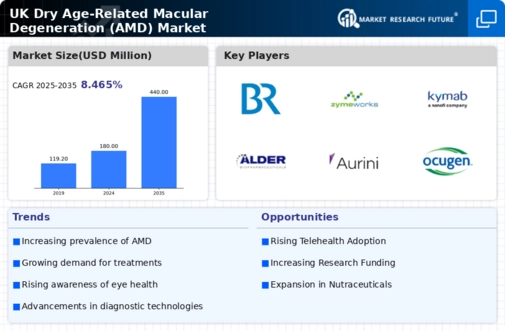Market Growth Projections
The Global UK Dry Age-Related Macular Degeneration (AMD) Market Industry is projected to experience substantial growth, with estimates indicating a market value of 3250 USD Million in 2024 and a potential increase to 6500 USD Million by 2035. This growth trajectory suggests a compound annual growth rate of 6.5% from 2025 to 2035. Such projections reflect the increasing demand for AMD treatments and the ongoing advancements in healthcare technologies. The market's expansion is likely to be driven by a combination of factors, including rising prevalence, improved awareness, and innovative treatment options.
Increasing Prevalence of AMD
The Global UK Dry Age-Related Macular Degeneration (AMD) Market Industry is experiencing growth due to the rising prevalence of AMD among the aging population. As the demographic landscape shifts, the number of individuals affected by AMD is projected to increase significantly. In the UK, it is estimated that by 2024, approximately 3250 USD Million will be allocated to AMD-related healthcare. This trend is expected to continue, with projections indicating that by 2035, the market could reach 6500 USD Million. Such figures suggest a pressing need for effective treatments and management strategies within the industry.
Advancements in Treatment Options
Innovations in treatment modalities are driving the Global UK Dry Age-Related Macular Degeneration (AMD) Market Industry forward. Recent developments in pharmacological therapies and surgical interventions provide new hope for patients. For instance, the introduction of novel anti-VEGF therapies has shown promise in slowing disease progression. These advancements not only enhance patient outcomes but also contribute to the economic growth of the market. As the industry evolves, the potential for new therapies could lead to a compound annual growth rate of 6.5% from 2025 to 2035, indicating a robust future for AMD treatment options.
Demographic Shifts and Aging Population
The demographic shifts towards an aging population are a primary driver of the Global UK Dry Age-Related Macular Degeneration (AMD) Market Industry. As life expectancy increases, the proportion of older adults susceptible to AMD rises correspondingly. This demographic trend is particularly pronounced in the UK, where the aging population is expected to drive demand for AMD-related healthcare services. The market's growth is anticipated to align with these demographic changes, as healthcare systems adapt to meet the needs of an older population. Consequently, the industry is poised for substantial expansion in the coming years.
Rising Awareness and Screening Programs
The Global UK Dry Age-Related Macular Degeneration (AMD) Market Industry benefits from increased awareness and proactive screening initiatives. Public health campaigns aimed at educating the population about AMD symptoms and risk factors have led to earlier detection and intervention. The National Health Service (NHS) in the UK has implemented various screening programs that encourage regular eye examinations, which may contribute to improved patient outcomes. As awareness continues to grow, the demand for AMD-related healthcare services is likely to escalate, further propelling the market's expansion in the coming years.
Technological Integration in Healthcare
The integration of advanced technologies into healthcare systems is reshaping the Global UK Dry Age-Related Macular Degeneration (AMD) Market Industry. Telemedicine, artificial intelligence, and digital health tools are enhancing patient monitoring and treatment adherence. For example, AI-driven diagnostic tools can facilitate early detection of AMD, leading to timely interventions. This technological shift not only improves patient care but also streamlines healthcare delivery, potentially reducing costs. As these technologies become more prevalent, they are expected to play a crucial role in the market's growth trajectory, aligning with the increasing demand for efficient AMD management.























Leave a Comment